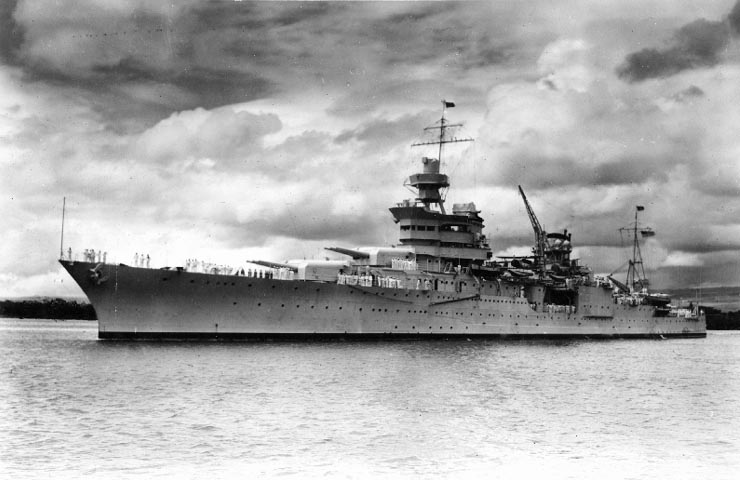
USS Indianapolis (CA-35)
It was Larry Sharpe’s dream to build an accurate model of the USS Indianapolis CA-35, a Navy cruiser sunk in action two weeks before the end of World War II. This event marked the greatest single loss of life at sea in the history of the U.S. Navy. Larry’s dream remained unfulfilled when he died unexpectedly in January, 2006. Happily, his dream came to fruition last month as the completed model was presented as a tribute to the service and sacrifice of her crew members.
Larry’s Dream Fulfilled
After his death, the partially finished model of the USS Indianapolis sat untouched in Larry Sharpe’s garage where the walls were covered with blueprints of this cruiser. Larry was a 28-year veteran of the U.S. Navy and an admirer of the men who lived and died on the Indianapolis. His model was to honor those who died in this tragic attack. Another woodworker in Lizton, Indiana tried to complete the model, but he was unable to do so.
Undaunted, Larry’s wife, Diane Sharpe, was determined to see the model of the USS Indianapolis completed. Last April, she loaded up the pieces of the 17-foot model and carried them in a box truck to the home of Harry Powell, a member of the Fleet Reserve Association, Memorial Branch 130. Mr. Powell was also a Navy veteran and shared Larry’s enthusiasm for the USS Indianapolis. Two months later the model of the USS Indianapolis that Larry started in 2005 was finally completed and unveiled last month. Larry’s dream had been fulfilled.
Noteworthy Place in Naval History
The USS Indianapolis holds a great, and tragic, place in naval history. She was commissioned in 1932 and received 10 Battle Stars for her exceptional service in World War II. As the war was nearing an end, the USS Indianapolis was called upon to perform a special mission. She departed San Francisco on July 16, 1945, and ten days later arrived at Tinian Island delivering parts and uranium for the first atomic bomb, nicknamed “Little Boy,” that was later dropped on Hiroshima. The cruiser was then ordered to Leyte Bay in the Philippine Sea to prepare for the invasion of Japan. The USS Indianapolis left Guam on July 28, 1945. Two days later, on July 30, 1945, she was hit by two torpedoes fired from a Japanese submarine. Of the 1,196 crew members, almost 600 crewmen perished as they floated in the shark- infested waters for four days. Only 316 men survived the ordeal.
Controversy surrounded this sinking. Captain McVay was given a court-martial by a hastily convened tribunal, but later he was exonerated and returned to active duty. Whatever the actual circumstances were, this was a sad and tragic day for the U.S. Navy.
Asbestos Use on Navy Cruisers
The USS Indianapolis, like other Navy ships, held many dangers for the men who served on them. Literally tons of asbestos insulating products were used to construct the USS Indianapolis and other Navy cruisers, battleships, and destroyers. The shipyard workers at New York Shipbuilding who built the USS Indianapolis were exposed to the asbestos dust generated from this massive amount of asbestos insulation. Other shipyard workers were exposed to asbestos as the USS Indianapolis underwent overhaul and repair at various shipyards.
Because of the asbestos use on Navy ships, the crewmen who served on the USS Indianapolis were exposed to the asbestos insulation on a daily basis as they maintained and operated the machinery and equipment that was covered with asbestos. Each time the asbestos insulation was installed and removed to allow for repairs, millions of hazardous asbestos fibers were released into the air. Asbestos exposure would also occur as the fibers became airborne from ship vibration and when the ship’s main guns were fired.
Thousands of shipyard workers and Navy seamen who worked on Navy cruisers were exposed to asbestos dust and the dangerous health risk associated with that exposure including the risk of contracting mesothelioma. Galiher DeRobertis & Waxman has represented many veterans who served on Navy cruisers and other warships. Their exposure to asbestos on these ships was the cause of their mesothelioma.
If you believe that you were exposed to asbestos in the Navy, you should be sure to inform your physician and have regular physical exams.






